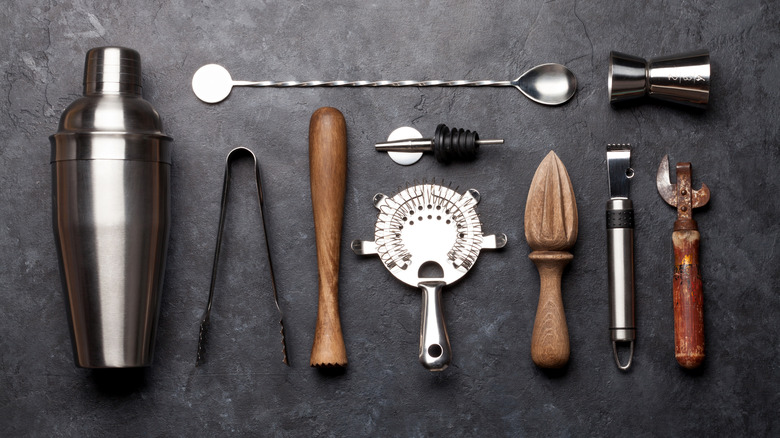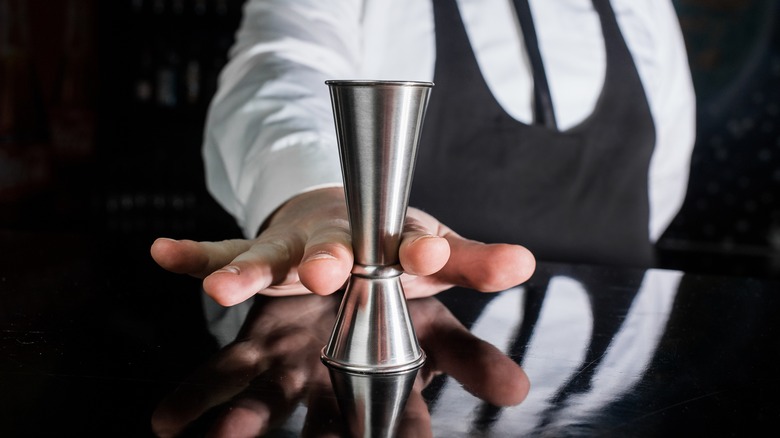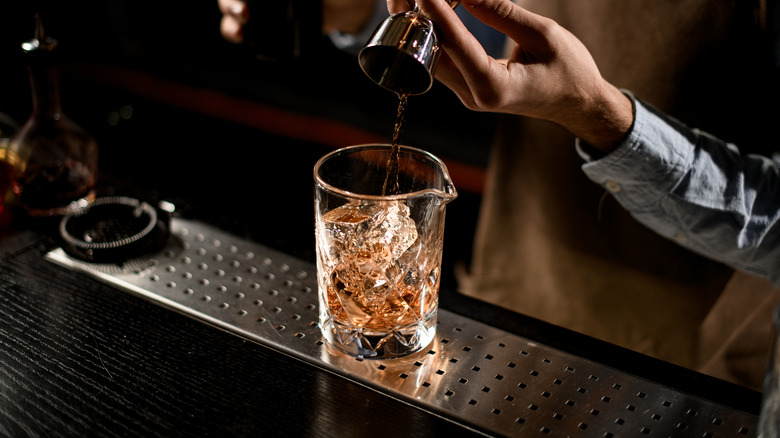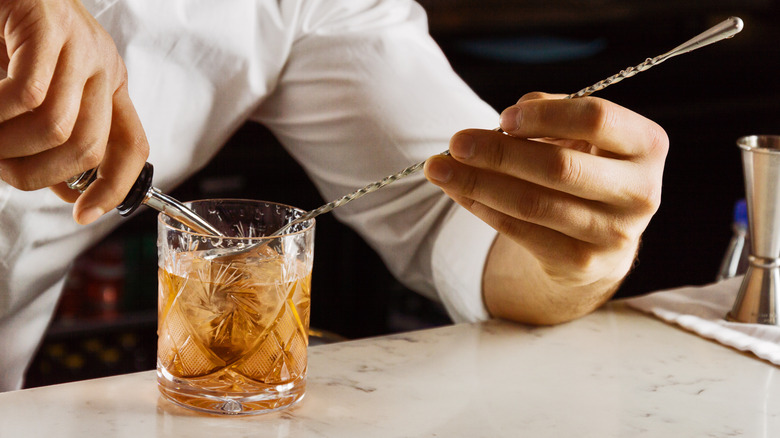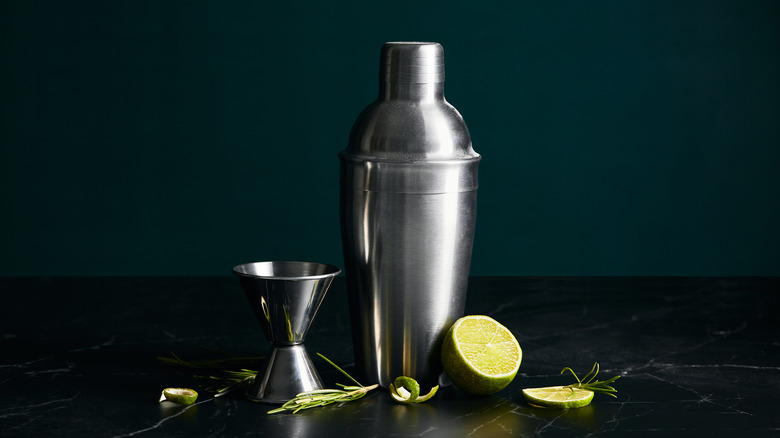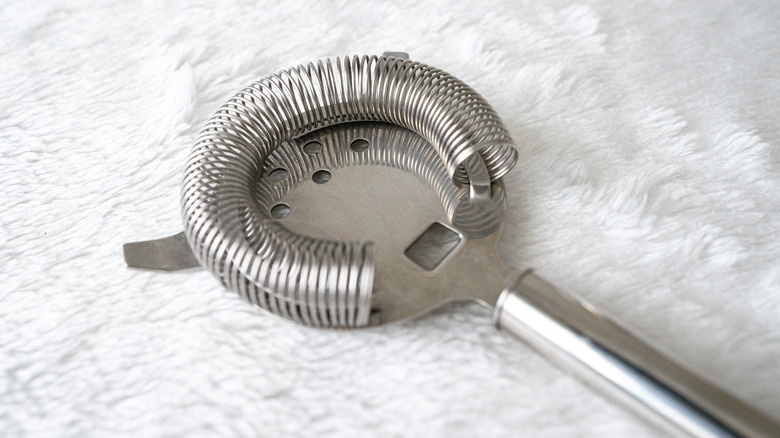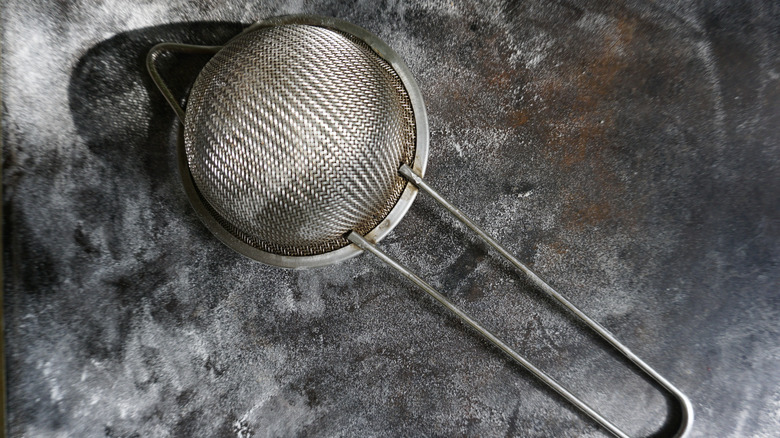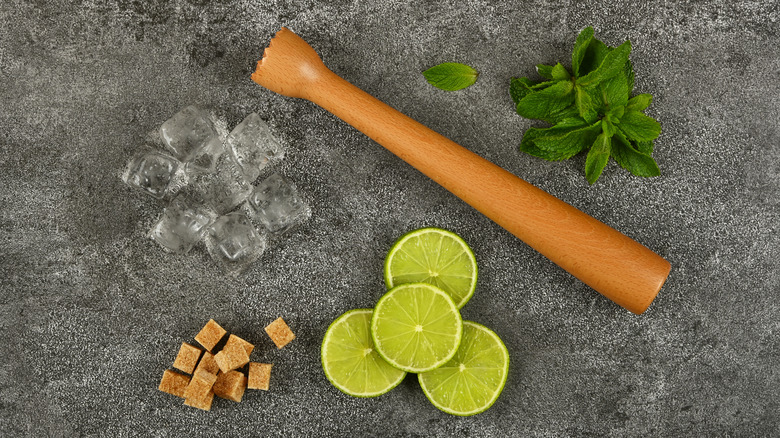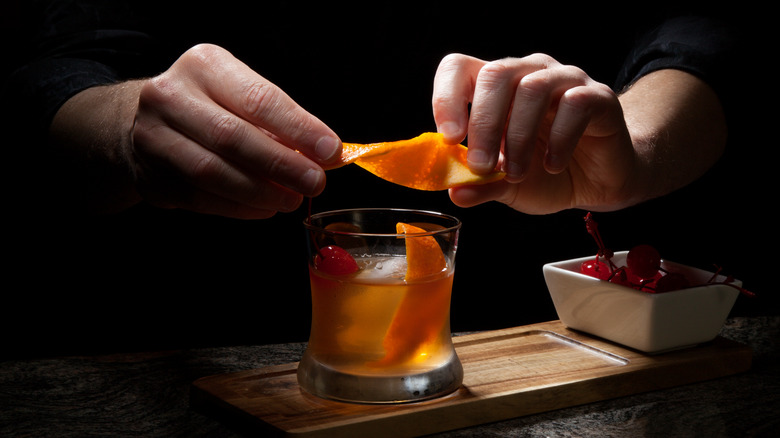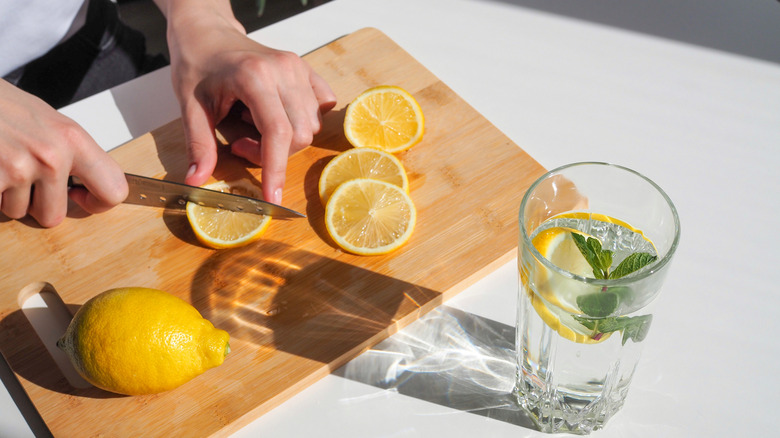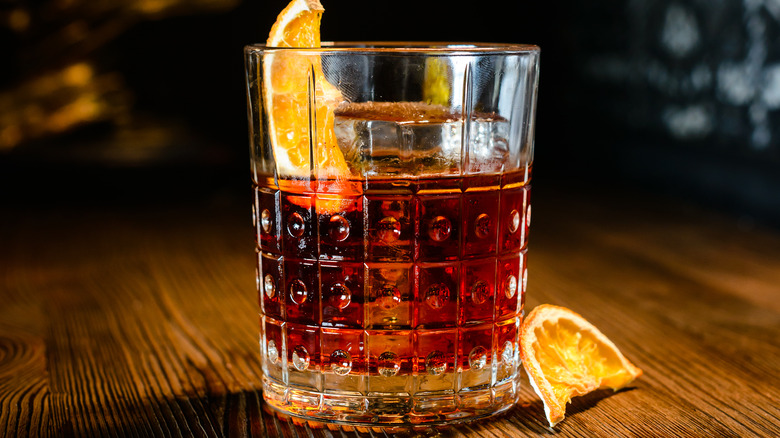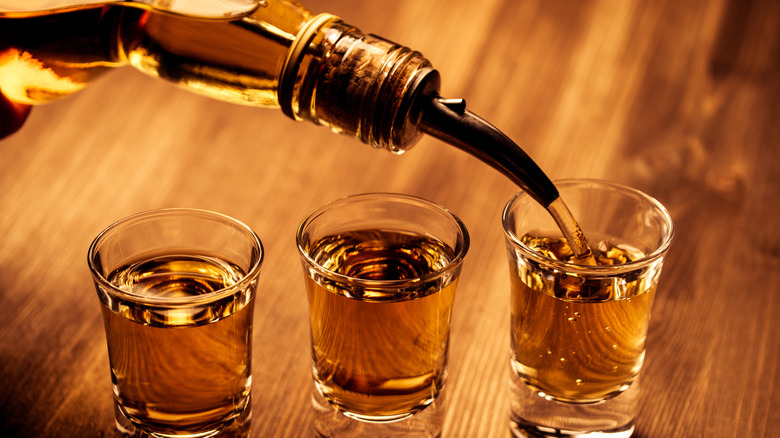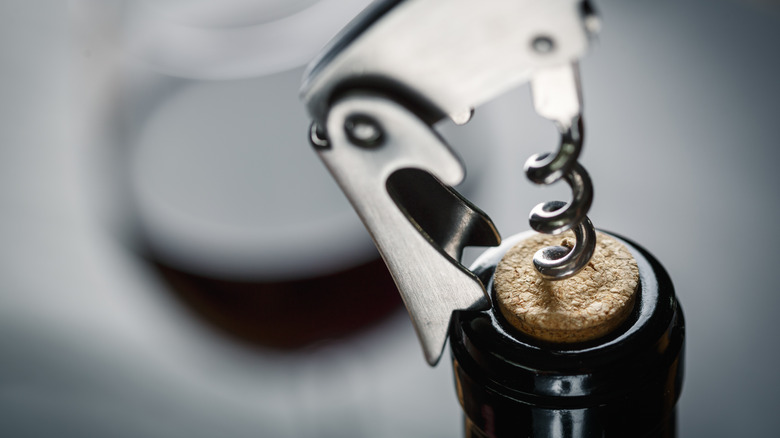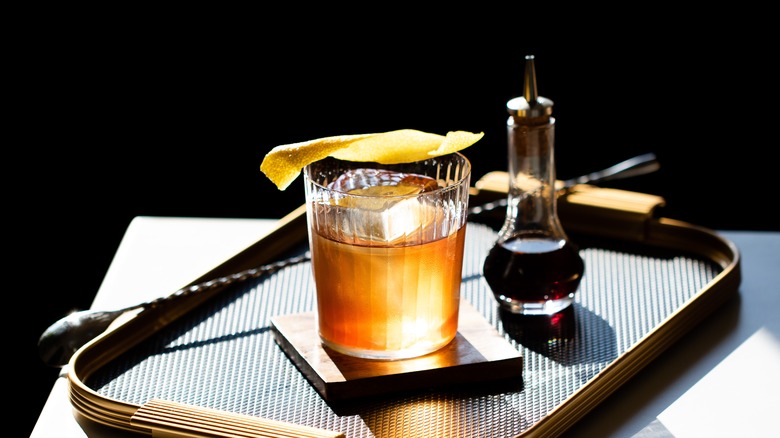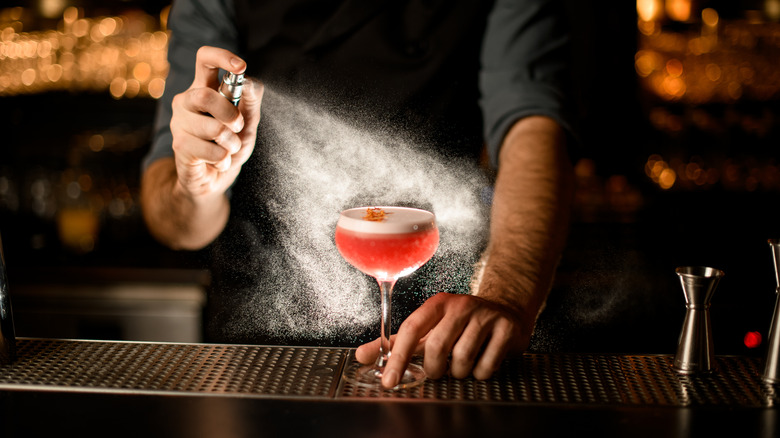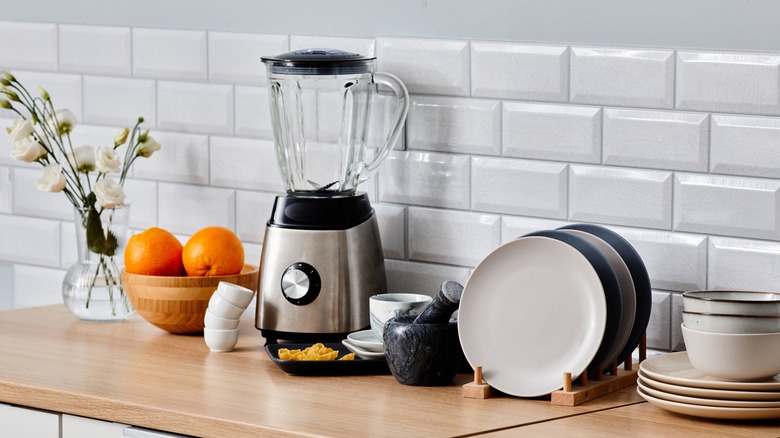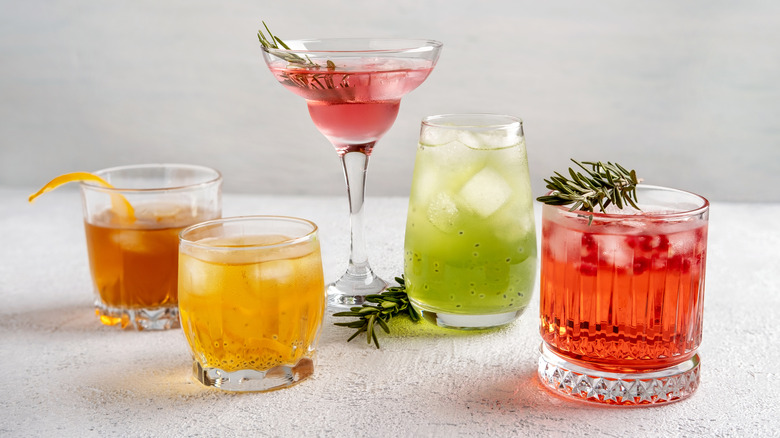17 Bartending Tools You Need For Your Home Bar
The current cocktail renaissance that is going on today has seen the rise of so many quality bars serving up expertly crafted drinks that are original, classic, and a combination of the two. However, you do not have to go out and spend money at a bar in order to enjoy a well-made drink. With a basic lineup of spirits, you can mix bar-quality cocktails well enough at home, but in addition to liquor, you will also need the right tools.
The factors that go into a great cocktail include everything from the ingredients themselves to the glass it is served in and everything in between. Plus, not all drinks are the same, and just as one recipe may call for different ingredients than another, that recipe can also require a different method of mixing the drink. In order to put your home bar to good use, you must have all of the essential tools available in order to cover as much ground as possible. So, here are the tools you need to bring your home bar to its maximum potential.
Jigger
Mixing great cocktails is really more of a science than it is an art. Precision is key to keeping things in balance, which is the essence of a good cocktail. A measuring device, or jigger, is perhaps the essential bartending tool there is. Without one, measuring out ingredients can only be done by estimation, and if you are not an expert bartender, doing so will not yield the best results.
Jiggers typically come as two small cups conjoining together, one of which is larger than the other. The larger cup will usually hold one-and-a-half ounces, and the smaller one just one ounce. The ideal jigger for your home bar would be one that has measurements etched onto it, or lines that runs along the inside of the cup indicating volume, ranging from a quarter-ounce to two ounces. Then, you can precisely fill the jigger to the exact measurement a recipe calls for without having to guess where the ¾ ounce mark is, for example.
Again, precise measurements simply make for better drinks, and the accuracy you get from using a jigger is far superior to guessing or using a shot glass.
Mixing glass
Once you have a jigger, you can then mix great drinks. A mixing glass is another essential tool for your home bar that will make stirring cocktails much more comfortable. Mixing glasses have a heavy, sturdy base, and a spout to make pouring the contents of the glass easier. Mixing glasses are also large enough to hold the volume needed for multiple drinks in addition to plenty of ice, so you can stir more than one cocktail at a time.
A mixing glass can be used for stirred cocktails like a martini, Manhattan, Negroni, and countless others. The reason certain cocktails are stirred rather than shaken is that stirring allows you to more easily control dilution. While shaking a cocktail gets the drinks colder faster, the amount of dilution imparted by doing so is less consistent.
Generally, cocktails that consist only of spirits and do not include citrus juice are stirred to retain a silky smooth texture. While you can certainly use a drinking glass to stir a cocktail, mixing glasses' sturdiness, width, spout, and stylish design make it a more practical, functional, and aesthetically appealing option.
Bar spoon
Subsequently, in order to stir a cocktail using your mixing glass, you will need an instrument to stir it with. That's where the bar spoon comes in. Bar spoons are long, very narrow tools with one spoon end with the other end serving a different function. This is part of the reason bar spoons are so essential to a home bar — they serve more than one purpose.
In addition to being the perfect shape for effortlessly turning ice around the glass to chill and dilute cocktails, there are plenty of cocktail recipes that call for bar spoon measurements of a certain ingredient. Bar spoon measureless is generally universal, which makes this even easier than measuring them out. The back of the spoon can also be used for layering ingredients on top of a finished drink. Plus, the other end of a bar spoon can have prongs for picking garnishes, or a can be flat discs used for muddling. It is possible your bar spoon will have nothing on the other end, which is easier for stirring for beginners.
Even the spiral shape of bar spoon necks serves a purpose. The thin, twisted shape is that way to not only helps the string motion but also for steadily pouring ingredients without the risk of splashing or spilling.
Shaker tin
Your home bar should not only be functional for stirred cocktails. There are cocktails that are meant to be shaken, and a good shaking tin is essential for doing so. As mentioned earlier, shaking cocktails gets them exceptionally cold and dilutes them very quickly. Additionally, shaking also aerates the cocktail, softening its texture. Shaking is done for cocktails that include ingredients like citrus juice or egg white to help combine everything more thoroughly. Basically, without a shaker, your bartending range is seriously limited.
There are different types of shakers to consider. The two most common are Boston shakers and cobbler shakers. Boston shakers are composed of two different tins that are locked together for shaking and then pulled apart to strain the drink, and cobbler shakers are three-piece shakers, including the body, strainer, and cap. Boston shakers do require a strainer to strain the drink out after it is shaken, but cobbler shakers have a strainer built in. Then, all you have to do is remove the cap and pour out the cocktail.
Both Boston shakers and cobbler shakers work very well, and either will serve your home bar effectively.
Hawthorne strainer
If you do have a Boston shaker or a mixing glass, you will need a Hawthorne strainer to go with it. Originally, bartenders used Julep Strainers for cocktails, but Nathaniel Hawthorne patented this upgraded version in the 1800s, inspired by tea strainers that serve a similar function.
Unlike the Julep strainer, the Hawthorne strainer has a spring that runs along the edge, allowing the strainer to fit snuggly on the rim of a shaker tin or mixing glass. Additionally, most Hawthorne strainers have a tab that allows you to press the strainer over the spring to better trap the contents of the shaker or glass. This is called "closing the gate" and helps to keep things like ice chips, muddled herbs, or fruit from getting into your cocktail glass.
You can certainly use a Julep strainer for stirred drinks and a Hawthorne strainer for shaken drinks, but if you were to get only one, the Hawthorne strainer checks off boxes the Julep strainer does not.
Fine mesh strainer
Even with a decent Hawthorne strainer, tiny bits of ice or solid ingredients can still make their way through to your drinking vessel. This is where a fine mesh strainer is necessary.
When you shake a cocktail very hard, as you should, the ice will most likely break apart into small pieces. And while Hawthorne strainers will trap most of these, some are so small that they still pass through. For cocktails served up, these tiny shards of ice will add extra dilution to the drink as they melt, throwing off its balance. So, double straining your cocktails through both a Hawthorne and fine mesh strainer is the best way to avoid this.
Additionally, in shaken drinks that call for muddled mint, herbs, or fruit, tiny bits can pass through a Hawthorne strainer just like ice shards. Using a fine mesh strainer to catch these extra bits simply makes for a better-looking cocktail, so your drinks come out clean without the concern of something getting into your glass or stuck in your teeth.
Muddler
Another essential tool for your home bar is a muddler. Muddlers are one of the more basic tools and are simply blunt objects used to crush sugar cubes, herbs, fruit, citrus wedges, or other solid ingredients.
Muddling is done to mint in cocktails like a mojito, for example, as well as to sugar cubes in something like an Old Fashioned. If you are into mixing drinks, chances are you have come across the need for a muddler. Even though you may not need it for most cocktails, they take up minimal space and come in handy when you do.
Muddlers can be made from wood, plastic, or stainless steel, which usually comes with a rubber end. Wooden muddlers are the most popular, but plastic or stainless steel options are easier to clean and are more hygienic. There are probably plenty of household items that can act as a substitute, but muddlers are so inexpensive that you might as well use a proper one.
Citrus juicer
It does not take much cocktail-making experience to understand the prevalence of citrus juice. Furthermore, it does not take long to realize how much better freshly pressed juice is than store-bought bottles of lime or lemon juice. Pressed juice tastes sweeter and fresher, and is simply better overall than storebought juice, which is often sour and bitter.
Juicing a lemon by hand, for example, is certainly doable, but will often cause the juice to spurt unpredictably, making a mess. Using a citrus press, however, will press the juice downward directly into your jigger, so you can extract the precise amount you need. The juicer will also catch any seeds or pulp from the citrus, so all that is left is the fresh juice.
Plus, if you are making a batch of cocktails, using a press will make things much less strenuous than squeezing each one by hand. If you are wondering how you can make bar-quality cocktails at home, freshly pressed juice is a good place to start.
Peeler
Another way you can achieve craft cocktail bar results in your own home is through the simple practice of adding fragrant and flavorful garnishes to your drinks. The most basic way to do this is through citrus peels. The peel of an orange, lemon, lime, or grapefruit can add a whole extra layer of complexity to a drink by both complimenting and enhancing the ingredients inside it.
The best peeler for cocktails is a Y-shaped peeler. These pull the most even, consistent peels with a uniform shape and the right amount of pith. You want a decent amount of pith on your peel, but not too much, which will result in more bitterness. With a sturdy, even peel, you can express the maximum amount of oils over the top of your cocktail and then place the express peel into the glass so you can enjoy the aromas throughout the drink.
It is possible to slice a peel using a knife, but a Y-shaped peeler is much easier and yields a better result. Fresh citrus peels will take your cocktail game to another level and pulling great peels is a simple step that goes a long way.
Sharp knife
While a simple citrus peel from a Y-shaped peeler will do just fine for a cocktail garnish, one way you can take a peel even further is by creating a decorative garnish out of it by getting crafty with a knife. After pulling a good peel, you can use a knife to neaten up the ends and give the peel a twist, or into a variety of different stylish garnishes. The look of a cocktail does contribute to the mood and experience of drinking it, and an aesthetic garnish does help make sipping a cocktail that much better.
You will also need a sharp knife to cut lime, lemons, and other citrus in half in order to juice them, as well as for cutting wedges and wheels for more simple garnishes. Of course, a sharp knife can be found in every kitchen, but it is important to have one handy for the home bar as well.
Ice molds
Every aspect of a cocktail contributes to its final form, and the ice you fill your glass with is no exception. Using specialty ice not only looks cool but also increases the quality of a cocktail in other ways.
Of course, ice keeps your drinks colder for longer, but the type of ice you use makes a difference in retaining the character of a drink in addition to keeping it chilled. For example, the standard ice cubes made by your freezer contain impurities that make it cloudy in appearance and melt faster. Instead of using a bunch of these smaller, dilution-sensitive cubes, you can use an ice mold to freeze large rocks. These are more attractive as well as melt slower, extending the life of your drink without adding as much dilution to it.
Other ice molds that form pebble ice are also handy for other types of cocktails that call for added dilution and a maximum chill. Also, the ice you use to shake a cocktail does contribute to different attributes. Shaking with one large cube will help with aeration, whereas cocktails that are served on ice can benefit from a whip shake with ice pebbles. Ice molds are simply another way to improve your home bartending and they are expensive and long-lasting.
Liquor pourers
Just like how a jigger helps accomplish accuracy, liquor pourers will help you pour your ingredients with precision and steadiness. You can obviously pour a spirit without a spout, but you do run the risk of overpouring and spilling. With a spout, you can ensure a steady stream with every pour and fill your jigger to the exact measurement every single time.
The reason behind the consistency of liquor pourers is the way the liquid moves through them. As the liquid passes through the spout, the air is circulated throughout the pourer and the bottle simultaneously. This, in addition to the silicone or rubber sealer that latches onto the bottle, creates this steady stream of the liquid into the long, narrow spout for a steady, leveled pour.
Bottle spouts can also be used for other ingredients like syrups and citrus juices, which you can bottle and refrigerate ahead of using them. No matter what you pour into a shaker tin or mixing glass, accuracy matters, and affixing pouring spouts to all of your bottles will only make for more seamless and efficient drink-making.
Bottle opener
This is another bartending tool that is already common, but a working bottle opener is a clear home bar essential. Part of what is great about having a well-stocked, well-equipped home bar is being able to mix great drinks for company as well as yourself. However, not everyone enjoys hard liquor or cocktails, and you should be able to serve them what they like.
Beer and wine are obviously very common, and oftentimes people preferred refreshments. Therefore, you ought to be able to crack open a bottle of beer or open up a bottle of wine for a guest. Most wine corkscrews are fitted with glass bottle openers as well, so a functional one will take care of both departments. There are plenty of wine openers on the market, but your best and least cumbersome option is a traditional wine key fit with a blade, lever, and corkscrew. Using these is very simple and they get the job done quickly.
Bitters dasher
Your home bar is not complete without at least a couple of bottles of bitters. Angostura, orange, and Peychaud's bitters, to name a few, contribute to an endless list of cocktails, essentially acting as a drink's seasoning, enhancing the flavors of the other ingredients.
Although bitters bottles come with a dashing top, your dashes will become irregular over time as more of the volume of bitters inside the bottle decreases. The more room there is between the bitters and the cap, the higher the liquid's velocity as it moves down the bottle. Then, one dash may turn out to be two or three dashes instead, which can throw your cocktail off balance.
In order to have consistent dashes every time no matter the amount of bitters you have left, transferring your bitters into some bitters dashers is a great investment for your home bar. The top of bitters dashers regulates the amount of bitters that pass through it, so each one is the exact same amount. Once you run out of bitters, you can simply remove the cap, add more, and keep on making perfectly balanced drinks.
Atomizer
This is one of the less common bartending tools, but one that deserves a place on your home bar. The reason you would use an atomizer is in doing so in place of rinsing a cocktail or glassware.
There are drinks that call for an absinthe rinse and some people like their martinis with a mere rinse of vermouth. This would normally call for pouring a very tiny amount of absinthe, vermouth, or whatever liquid into the glass, rotating the glass so that it coats the entire surface, and then dumping the excess.
With an atomizer, you put the liquid inside and spray a coat into the glass that is aromatic, even, and will hold on to the surface. There are also cocktails that call for the floating of liquor on top of the strained drink. For example, the modern classic Penicillin is finished by floating a quarter-ounce of Islay Scotch on top of the cocktail. With an atomizer, you would be able to spray the Islay scotch atop the drink for a fuller, more evenly distributed accent.
Blender
Just like bottle openers, knives, and peelers, the blender is another common kitchen appliance that is also a great addition to your home bar. When summertime and hot weather come around, a bright and refreshing cocktail is always a great way to keep cool. What is even better than an ice-cold drink, however, is one that is actually frozen.
Frozen cocktails take the refreshment of drinks to the next level and you can only enjoy one with a blender. Frozen margaritas are always a classic option and are as easy as adding margarita ingredients with ice and blending. Frozen daiquiris and piña coladas are also classic options, as is a more modern frozen take on a traditional cocktail, the Frozen Negroni, or "fro-groni."
A blender can also come in handy when making various cocktail syrups, so its use does not end at frozen boozy treats. You probably already have a blender at home, so considering it for mixing drinks is a given.
Recipe book
If you are new to mixing cocktails and you have all of the necessary tools to help you get started, you also have to know what to do with them. So, a comprehensive cocktail recipe book is just as essential as any other item on this list.
The number of cocktails that exist is pretty much endless, so it is best to start with the basics and the classics before moving on to more modern and complex recipes. A solid cocktail recipe will not only give you a basic foundation for what makes a great drink, but it will also help you stock your home bar with the most fundamental spirits. Then, the more books you read, the further into the endless rabbit hole of cocktails you can explore.
Since it's best to start with classic cocktails, focus on books that feature them. There are the classic cocktail books that still guide bartenders today as well as books published by modern bars detailing their philosophy and approach to drink-making inspired by the past and fueled by the present. The wealth of knowledge out there is rich and exciting, so get some books and start mixing.
